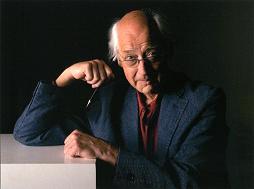|
Jacob van Eyck Quarterly |
2007, No. 4 (October) |
||
|
Jacob van Eyck gets a medal
Jacob van Eyck Year 2007 inspired the Dutch sculptor and medalist Theo van de Vathorst (1934) to design a commemorative medal for the Utrecht Orpheus. Van de Vathorst is himself a native of Utrecht, and his roots as an artist are firmly planted in the city. He designed the bronze doors (1996) of the Dom Cathedral as well as the 'Poultry Wife' overlooking the Vismarkt, Utrecht's former Fish Market. These monumental works contrast sharply in size to the Van Eyck medal, which measures just 60 mm (2,36 inches) in diameter. Van de Vathorst became interested in art medals at a young age, via his teacher Piet Esser at the Rijksacademie in Amsterdam. Contact with the Vereniging voor Penningkunst (Dutch Art Medal Society), established in 1925, intensified his fascination for the genre. The art medal originated during the Italian Renaissance as a commemorative token. The Society's goal of keeping this tradition alive consists in part of issuing two medals per year exclusively for its members. Theo van de Vathorst sat on the board of directors as artistic member from 1981 to 1989.
The Van Eyck medal sublimely illustrates that inventiveness. The obverse depicts the blind master in a chair. It is a detail from the well-known nineteenth-century litho found in the Lauwerbladen uit Neêrlands gloriekrans (1875-1879) by W.J. Hofdijk, a Romantic impression of Van Eyck testing the bells cast and demonstrated by the Hemony brothers (see illustration). A medal is, of course, far too small to reproduce the entire tableau, so Van de Vathorst made this side of the medal slightly concave, as though Van Eyck is actually sitting within a bell. The medal, as it were, makes music.
The reverse shows the text '2007 hommage [image] Jacob van Eyck †1657' and depicts Van Eyck playing the recorder for burghers out for an evening stroll in the Janskerhof. The medal thus brings together Van Eyck's activities, exemplifying Van de Vathorst's vision of the art medal. "I always look for a relationship between the two sides," he says. "They have to have an inherent unity." And thus a medal tells a story.
Theo van
de Vathorst's atelier is located in the Geertestraat in Utrecht, only
a couple of hundred yards from where
Jacob van Eyck lived. In 1997, Queen Beatrix awarded the artist
a knighthood in the Order of the Lion of the Netherlands.
Thiemo Wind (Translation: Jonathan Reeder)
Literature: Louk Tilanus, Theo van de Vathorst - Het beeld en het verhaal. Zwolle: Waanders, 2004. [with a summary in English.] Website:
www.vandevathorst.nl
|
|||
|
Quarterly 2008 / 1 will appear in January Interested in receiving a reminder? Send an e-mail: Did you reach this page through a search engine? Click below to go to the |
|||


